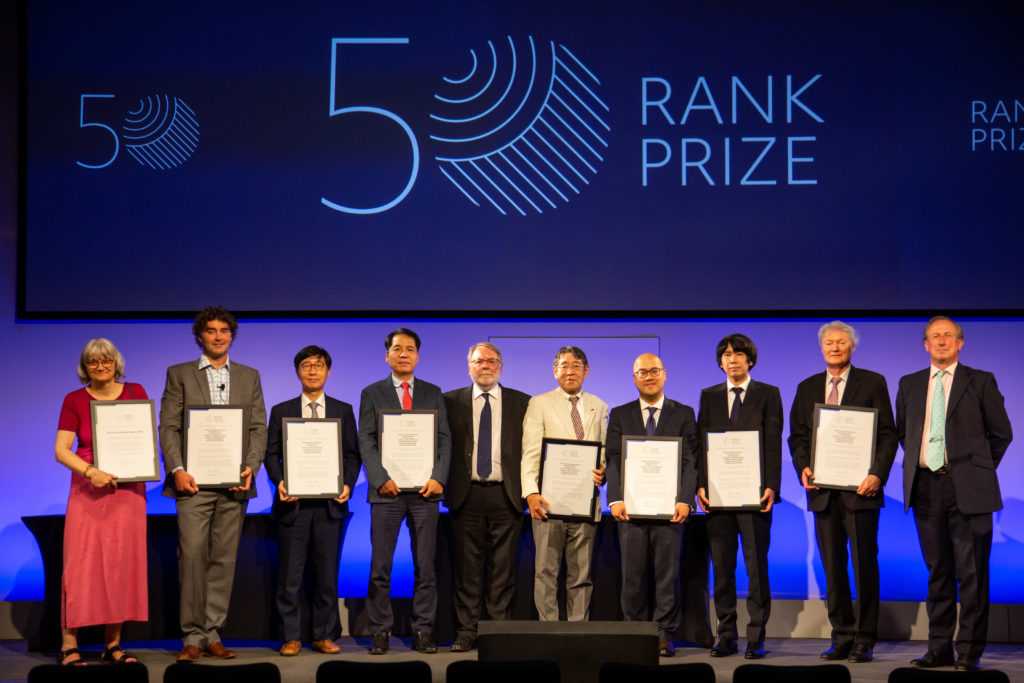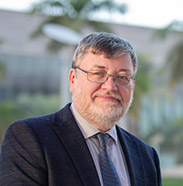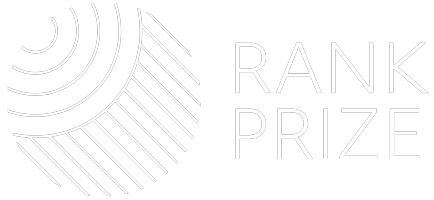2022 winners







Rank Prize for Optoelectronics
For the discovery and development of all-solid-state perovskite semiconductor solar cells
Professor Michael Graetzel
Dr Akihiro Kojima
Dr Michael Lee
Professor Tsutomu Miyasaka
Professor Nam-Gyu Park
Professor Sang Il Seok
Professor Henry Snaith
The 2022 Rank Prize for Optoelectronics is awarded to seven internationally leading scientists, from several research laboratories, who have pioneered the development of new solar cell technology based on perovskite semiconductors which promises to play a key role in the future of solar power.

2022 marks the 50th anniversary of Rank Prize, which has been celebrating outstanding scientific breakthroughs since 1972. The Rank Prize is awarded biennially in the fields of optoelectronics and nutrition: two areas related to Lord Rank’s business interests. The prize is awarded to individuals who have made a significant contribution in these fields, where an initial idea has been carried through to practical application that has or will have demonstrable benefit to humanity.

The Rank Prize Optoelectronics Committee is delighted to recognise the outstanding achievements of these internationally leading researchers. Their work is a key example of fundamental contributions to physical science being rapidly and successfully translated into new technology, technology moreover that is poised to address truly urgent societal challenges linked to climate change. It is particularly gratifying that we have been able to announce this recognition in the lead up to the COP26 UN Climate Change Conference.
Professor Donal Bradley CBE FRS Chair, Optoelectronics Committee
Why the work of these scientists is so important
Generating electricity from solar power is of crucial and urgent importance to the transition away from burning fossil-fuels as sources of energy, as needed to tackle man-made climate change. Typical commercial solar cells are based on the absorption of light from the sun by silicon – a widely available elemental semiconductor. But silicon photovoltaic cells do not reach the maximum efficiency that is theoretically possible. So, researchers and technologists have been urgently seeking more efficient alternatives – especially ones that could be cheaper and easier to manufacture.
The scientists recognised by this award demonstrated the early potential of so-called perovskite semiconductors (and more particularly organic-inorganic lead halide perovskite semiconductors) to work as the active layer in solid-state photovoltaic solar cells and, latterly, to be deployed in tandem cells with silicon. Together, they have driven development of this new technology with their collective expertise in chemistry, materials science, physics and engineering.
The rapid progress of perovskite cells
Perovskite semiconductors are layered materials, originally based on compounds of the form ABX3, where A is an organic molecular ion, B a metal and X one of several halides – chlorine, bromine or iodine. The prize winners have developed these materials through several challenging iterations, leading to a rapid increase in efficiency from initial values of less than 4% until now, in 2021, we have solid-state, perovskite semiconductor solar cells that operate at 25.5% efficiency – comparable to the 26.1% efficiency of silicon counterparts.
This rapid development has stimulated an explosion of interest within the global research community and it is attracting major attention from industry. This interest has initially focused on hybrid structures that pair the perovskite solar cell with a conventional silicon solar cell to form a tandem structure with increased power efficiency. It now seems that perovskite solar cells will play a major role in the future of solar power.
Professor Michael Graetzel: “I was overjoyed when I learned I was one of the recipients of the 2022 Rank Prize for Optoelectronics and wish to express my sincere congratulations to my fellow laureates. I take this opportunity to express my deepest gratitude to my co-workers and colleagues for their precious help in accomplishing this remarkable breakthrough and to Rank Prize for awarding this prestigious prize to myself and the other awardees.”
Dr Akihiro Kojima: “I am greatly honoured to receive the 2022 Rank Prize for Optoelectronics. I am pleased to have been involved in the early research of applying organometal halide perovskites to solar cells. It is a pleasure to share this honour with my supervisors.”
Dr Michael Lee: “Over a decade has passed since I started to work on hybrid perovskite materials for optoelectronics and I continue to be impressed at the pace of progress and sustained innovation in this field. It is wonderful news for established and early career researchers working with hybrid perovskite optoelectronics that the Rank Prize is acknowledging their exciting research area.”
Professor Tsutomu (Tom) Miyasaka: “Study of halide perovskite photovoltaics has made remarkable contributions to a wide range of academic disciplines in the intersection of chemistry and physics. It is an honour for the members who pioneered this interdisciplinary study to be selected to receive this Rank Prize award with me. I’m particularly happy that Kojima, who worked on the first experiment with me, was selected. I hope that young researchers will pioneer this field and lead to new discoveries.”
Professor Nam-Gyu Park: “It is my great honour to be an awardee of the Rank Prize. My enthusiastic journey to discover more efficient, affordable and viable photovoltaic materials and technologies brought me to the organic-inorganic halide perovskite. The discovery of perovskite solar cells was not accidental but inevitable. Since the discovery and the progress of perovskite solar cells would not be possible without my colleagues, I am pleased to share this honour with them.”
Professor Sang Il Seok: “It’s a great pleasure to be awarded the prestigious Rank Prize and I sincerely thank Rank Prize’s Optoelectronics Committee for recognising perovskite solar cells as a promising solar power harnessing technology, by giving this year’s Rank Prize award to myself and fellow researchers in the field.”
Professor Henry Snaith FRS: “It is a great honour to be awarded this prize, alongside my colleagues in the field who have contributed significantly to the discovery and advancement of perovskite solar cells. The last ten years have been an unexpected and unbelievable journey of discovery, and the next decade promises to be equally exciting, as we enable the industrialisation of perovskite photovoltaics and accelerate the global transition to carbon-free energy production.”
About our seven Rank Prize-winning scientists
Professor Michael Graetzel
Michael Graetzel is a Professor at Ecole Polytechnique Fédérale de Lausanne (EPFL) where he directs the laboratory of photonics and interfaces. He received his PhD from the Technical University in Berlin in 1971. After postdoctoral training at the University of Notre Dame, USA, he joined EPFL as a Professor in 1977. He pioneered research on energy and electron transfer reactions in mesoscopic systems and their use to generate electricity and fuels from sunlight. His dye-sensitised solar cells led to the advent of perovskite solar cells – the most exciting breakthrough in the recent history of photovoltaics. A recent ranking by Stanford University places Graetzel in the first position on top of a list of 100,000 worldwide leading scientists across all fields.
Dr Akihiro Kojima
Akihiro Kojima received a Master of Engineering in Photo-Optical Engineering from Tokyo Polytechnic University in 2007, and a Doctor of Philosophy in Multidisciplinary Sciences from The University of Tokyo in 2010. After graduation, he joined Peccell technologies, Inc. and started developing the flexible photovoltaic cell. In 2018, he moved to Zeon Corporation. He studied the optical properties of organic-inorganic layered perovskite compounds in 2004, and undertook research on applying organometal halide perovskites compounds to dye-sensitised solar cell as visible light sensitisers from 2005 to 2010.
Dr Michael Lee
Mike is currently the editor of Science Robotics – a multidisciplinary research journal covering the latest advances in robotics. Before joining, he was a co-founding editor of Nature Electronics where he served the journal in San Francisco, USA. Mike started his editorial career at Nature Communications in London as an associate editor handling applied physics and engineering research. Before working in scientific publishing, Mike conducted research at the Paul Scherrer Institute in Switzerland as a Marie Skłodowska-Curie Intra-European fellow and later completed his doctoral training at the University of Oxford. Mike has published research in various magazines and journals (including Science and Nature Communications) and is a named inventor on international patents.
Professor Tsutomu (Tom) Miyasaka
Tsutomu Miyasaka completed the Graduate School of Engineering at the University of Tokyo in 1981 (Doctor of Engineering). He founded Peccell Technologies, Inc. in 2004 and is the CEO. He’s currently a project professor at TUY and a fellow of Research Center of Advanced Science and Technology at the University of Tokyo. His research specialises in photoelectrochemistry and hybrid photovoltaic cells, especially halide perovskite solar cells. His awards include: Chemical Society of Japan Award (2017), PVSEC Hamakawa Award (2017), Clarivate Analytics Citation Honor Award (2017), Japan Society of Applied Physics Achievement Award (2019), and Ichimura Academic Award (2020).
Professor Nam-Gyu Park
Nam-Gyu Park is Professor of Chemical Engineering at Sungkyunkwan University (SKKU) in Suwon, South Korea. He received his PhD in Chemistry from Seoul National University in 1995. He joined SKKU as a full professor in 2009 after postdoctoral experiences at ICMCB-CNRS in France and NREL in the USA, and professional experiences at KIST and ETRI in Korea. In 2012, Park’s group was the first to report a long-term stable perovskite solar cell. This opened a new research area, so-called perovskite photovoltaics. The group have been undertaking research on materials and devices engineering for high efficiency perovskite solar cells. They’re developing superb efficiency perovskite solar cells along with long-term stable large-area processing technologies for commercialisation.
Professor Sang Il Seok
Sang Il Seok is a Distinguished Professor at the Department of Energy and Chemical Engineering in Ulsan National Institute of Science and Technology (UNIST), South Korea. His studies are mainly focused on functional inorganic-organic hybrid materials and devices for energy harvesting. His group presented for the first time an inorganic-organic hybrid perovskite heterojunction solar cell that operates completely differently from perovskite-sensitized solar cells, which is currently one of the prototypes of high-efficiency perovskite solar cells. The device architecture devised by his group provided the basis for continuously updating the efficiency of perovskite solar cells to over 25%, surpassing those of conventional thin-film solar cells. His group holds the world record for the most efficient (25.5%) perovskite solar cell, as certified by the National Renewable Energy Laboratory, US.
Professor Henry Snaith FRS
Henry Snaith is a physicist working on new materials and devices for photovoltaic solar energy conversion. He discovered that a new type of solar cell material, perovskites, can produce extremely efficient solar cells when integrated into a simple thin-film device, which are also very easy and cheap to manufacture. He promises to deliver the next generation of improved photovoltaics for powering the world towards net zero. Henry is intimately involved in the commercialization of this technology, as co-founder and Chief Scientific Officer of Oxford PV Ltd. Oxford PV is building the first full-scale production line based on his perovskite technology.


